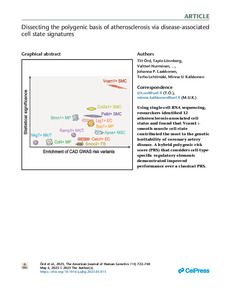Dissecting the polygenic basis of atherosclerosis via disease-associated cell state signatures
Örd, Tiit; Lönnberg, Tapio; Nurminen, Valtteri; Ravindran, Aarthi; Niskanen, Henri; Kiema, Miika; Õunap, Kadri; Maria, Maleeha; Moreau, Pierre R.; Mishra, Pashupati P.; Palani, Senthil; Virta, Jenni; Liljenbäck, Heidi; Aavik, Einari; Roivainen, Anne; Ylä-Herttuala, Seppo; Laakkonen, Johanna P.; Lehtimäki, Terho; Kaikkonen, Minna U. (2023-05)
Örd, Tiit
Lönnberg, Tapio
Nurminen, Valtteri
Ravindran, Aarthi
Niskanen, Henri
Kiema, Miika
Õunap, Kadri
Maria, Maleeha
Moreau, Pierre R.
Mishra, Pashupati P.
Palani, Senthil
Virta, Jenni
Liljenbäck, Heidi
Aavik, Einari
Roivainen, Anne
Ylä-Herttuala, Seppo
Laakkonen, Johanna P.
Lehtimäki, Terho
Kaikkonen, Minna U.
05 / 2023
Julkaisun pysyvä osoite on
https://urn.fi/URN:NBN:fi:tuni-202305256132
https://urn.fi/URN:NBN:fi:tuni-202305256132
Kuvaus
Peer reviewed
Tiivistelmä
Coronary artery disease (CAD) is a pandemic disease where up to half of the risk is explained by genetic factors. Advanced insights into the genetic basis of CAD require deeper understanding of the contributions of different cell types, molecular pathways, and genes to disease heritability. Here, we investigate the biological diversity of atherosclerosis-associated cell states and interrogate their contribution to the genetic risk of CAD by using single-cell and bulk RNA sequencing (RNA-seq) of mouse and human lesions. We identified 12 disease-associated cell states that we characterized further by gene set functional profiling, ligand-receptor prediction, and transcription factor inference. Importantly, Vcam1+ smooth muscle cell state genes contributed most to SNP-based heritability of CAD. In line with this, genetic variants near smooth muscle cell state genes and regulatory elements explained the largest fraction of CAD-risk variance between individuals. Using this information for variant prioritization, we derived a hybrid polygenic risk score (PRS) that demonstrated improved performance over a classical PRS. Our results provide insights into the biological mechanisms associated with CAD risk, which could make a promising contribution to precision medicine and tailored therapeutic interventions in the future.
Kokoelmat
- TUNICRIS-julkaisut [16951]
